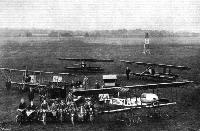
Описание
Страна: Великобритания
Год: 1915
Единственный экземпляр
J.Bruce British Aeroplanes 1914-1918 (Putnam)
Hall School Biplane
J.L. HALL was one of the pre-war British exhibition pilots: he took his R.Ae.C. aviator’s certificate .(No. 291) at Hendon on September 17th, 1912, flying a Bleriot monoplane. In the summer of the following year he opened a flying school at Hendon.
His school had at least one Caudron biplane up to the outbreak of war, but on November 7th, 1914, there occurs the first mention of the Hall Biplane: on that aircraft J. H. Rose “took his ticket” at Hendon on that date.
The Hall Biplane consisted of the wing structure and undercarriage of a Caudron G.II married to a new fuselage and tail-unit: there may have been some direct connexion with the school’s original Caudron. The mainplanes were quite unchanged in any way, and retained the characteristic covering which gave a double-surface wing only between the spars. Lateral control was by wing-warping. The lower booms of the original Caudron were cut off where the first inter-boom struts were situated, and provided a useful pair of skids in the undercarriage.
Power was provided by an 80 h.p. Gnome rotary motor, and the simple fuselage carried an equally simple tail-unit and tail-skid.
The Hall Biplane was still in use at the end of 1915, by which time thirty-five pilots had qualified for their R.Ae.C. certificates on it.
SPECIFICATION
Constructors: The Hall Aviation Co., London Aerodrome, Hendon.
Power: 80 h.p. Gnome.
Dimensions: Span: 38 ft 9 in.
Areas: Wings: 300 sq ft.
Описание:
- J.Bruce British Aeroplanes 1914-1918 (Putnam)
- M.Goodall, A.Tagg British Aircraft before the Great War (Schiffer)
- Журнал Flight
Фотографии
-
J.Bruce - British Aeroplanes 1914-1918 /Putnam/
Hall Biplane.
-
Журнал - Flight за 1915 г.
THE LATEST TRACTOR BIPLANE AT THE HALL FLYING SCHOOL, HENDON. - Three-quarter view from the front.
The Hall biplane of 1914-1915 used Caudron wings. -
Журнал - Flight за 1915 г.
THE LATEST TRACTOR BIPLANE AT THE HALL FLYING SCHOOL, HENDON. - Three-quarter view from the back.
-
Журнал - Flight за 1915 г.
A recent photograph of a number of pupils and machines of the Hall Flying School, Hendon. Mr. Hall is standing in front of machine No. 4, on right of propeller.
Другие самолёты на фотографии: Caudron C / D / E - Франция - 1912




